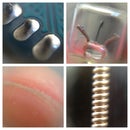Introduction: LiPo-Powered Arduino
Let's face it, 9V batteries suck. They don't last long, they're expensive, and did I mention they don't last long? I work on and run several electric RC cars, and because of this I own a lot of Lithium Polymer (LiPo) batteries. Nowadays you can get them for pretty decent prices, and if you know how to take care of them (don't ever use them if you don't) they'll last you a long, long time.
While your average pile alkaline 9V has a capacity of about 565mAh and costs somewhere around $2, a budget 2S (7.4V) LiPo pack that costs $9 can have a capacity of 1800mAh, with the bonus of 1,000+ charge cycle capability.
To use my LiPo packs on my Arduino, I made a simple adapter from Deans Ultra (the type of plug I have soldered onto all my LiPos) to the barrel plug that fits into the Arduino. Make sure that when you use a LiPo for an extended period of time, or any time at all for that matter, always connect it to a low-voltage cutoff (if your LiPo drops below 3.0V per cell, you're pretty much dead in the water).
Now I can run my Arduino away from the wall or computer for long periods of time and for a low cost, and you can, too!
If you think this is a good tip, please vote for this Instructable in the Electronics Tips and Tricks contest! The vote button is in the top right of this Instructable, right above the title. Thanks!

Participated in the
Electronics Tips and Tricks

Participated in the
Hurricane Lasers Contest

Participated in the
Fix & Improve It Contest













